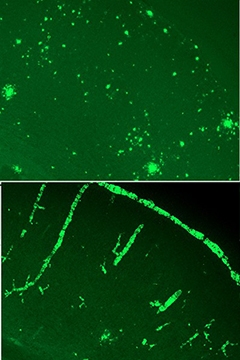Snapshots from the Society for Neuroscience Annual Meeting
Quick Links

At around 29,000 registrants, this year’s Society for Neuroscience annual meeting, held October 17-21 in Chicago, was slightly smaller than those of years past. More noticeably for Alzheimer’s researchers, the number of oral and poster presentations on AD has been shrinking in recent years as well, and this trend continued this year. There were no minisymposia on the SfN subtheme of AD and other dementias, and just seven nanosymposia—down from 11 in 2014. Some scientists lamented that SfN is no longer a must-go for AD researchers. Even so, the nanosymposia, almost 500 posters, special lectures, and satellite events on this research area did yield enough to quench a thirst for the basic science behind neurodegenerative disorders. Below is a snapshot of some of the highlights.
A theme that continued to impress attendees was the role of the immune system in neurodegeneration. In her Presidential Special Lecture, Beth Stevens, a pioneer in this field and recent recipient of a MacArthur fellowship, showed new evidence for how complement proteins of the innate immune system mediate microglial digestion of synapses in developmental disorders such as schizophrenia and neurodegenerative diseases such as AD. This mechanism may underlie Aβ’s ability to damage synapses, since lack of a key complement protein renders the peptide harmless, Stevens said. In other presentations, researchers expanded on the idea that some synapses display an “eat me” signal that invites aberrant pruning in several disorders. Meanwhile, Stevens’ group at Boston Children’s Hospital identified a corresponding “don’t eat me” signal that shields synapses from such gastronomic humiliation.

Bin This.
Silencing Bin1 (right) ramps up endosomes as seen by accumulation of the marker Rab5 (purple), but limits axonal trafficking of BACE1 (green). [Image courtesy of Claudia Almeida, Universidade Nova de Lisboa.]
Microglia and the immune system have risen to prominence in AD research because genome-wide association studies identified risk loci near genes for microglial proteins and immune signaling molecules. In Chicago, scientists reported how they are making inroads into the still-mysterious functional effects of GWAS variants in Bin1, Clu, ABCA7, CR1, and TREM2. Bin1 seems to affect endosomal trafficking (see image), though scientists debated where the protein acts, with one group suggesting it’s in axons and another suggesting synapses. Knockout mice yielded strong evidence that clusterin modulates clearance of Aβ from the parenchyma into blood vessels. An ABCA7 variant appears to alter splicing of the gene, both changing the protein’s structure and reducing its amount. The alternative splice variant also occurs in some people who do not harbor the corresponding GWAS SNP, suggesting that other upstream factors influence production of that splice variant, and that these factors converge to potentially alter microglial phagocytosis of Aβ. Other scientists reported that while alternatively spliced forms of CR1 that correspond to GWAS SNPs are expressed at similar levels in control and AD brains, they bind more tightly to complement factors C1q and C3b. Finally, new evidence that TREM2 tones down tau pathology was in keeping with the idea that microglia mop up unwanted proteins in the brain.
Beyond GWAS hits, scientists have begun to screen panels of wild-type mouse strains to map novel genetic variants that modulate AD-relevant behavioral phenotypes such as learning and memory, or that interact with genes identified in human GWAS. Researchers mapped loci in smarter mice to the gene for a chromatin-binding protein. That regulator seems to controls expression of an autophagy gene that is upregulated in people with AD.

No Clu.
APP/PS1 mice lacking the clusterin gene accumulate vascular A deposits (green, bottom) as opposed to parenchymal plaques found in control mice (top). [Image courtesy of John Fryer, Mayo Clinic.]
Science also continues to learn from mice that model human genetic variation, for example trisomy 21, the cause of Down’s syndrome. At SfN, researchers reported that treating DS model mice soon after birth, or even treating their murine moms prenatally, can normalize brain development and prevent cognitive impairment. If this finding holds up, it would represent a sea change in how researchers view the condition. The data have raised hopes for similar strategies in children with Down’s, though numerous hurdles remain, including finding a treatment safe enough for use during pregnancy. Possible agents for this type of intervention include inhibitors of the kinase DYRK1A, which stimulates inhibitory interneurons, and serotonin selective reuptake inhibitors, such as Prozac, which seemed to normalize brain development when given to pups prenatally or right after birth. Overall, there seemed renewed hope that one day researchers may be able to help brain development in children with the extra chromosome.
Researchers described novel therapeutic approaches for neurodegenerative diseases and updates on therapeutics already in preclinical testing. Immunotherapies for Alzheimer’s, Parkinson’s, and related conditions ran the gamut from antibodies against pyroglutamate-modified Aβ that cleared plaques in AD mouse models and improved their learning and memory, to oligomer-directed antibodies that prevented cross-seeding of tau with α-synuclein, and rescued synapses and movement phenotypes in mouse models of PD. Others reported on small-molecule approaches for AD and PD targeting the protein phosphatase calcineurin, a microglial purine receptor, a metabotropic glutamate receptor, tyrosine kinases, and the Parkinson’s gene DJ-1.
This year’s SfN meeting reflected incremental progress in understanding how trauma affects the brain. Scientists claimed that brain injuries have variable effects depending on factors such as sex, age, and even diet. They proposed underlying mechanisms for cognitive problems associated with traumatic brain injury, such as disrupted autophagy, poor DNA methylation, loss of dopamine signaling, and axonal injury. Other groups identified possible neuroprotective factors, such as a transcription factor that rises after injury to boost expression of antioxidant proteins. Several speakers reported on potential therapeutics, including antioxidant drugs, hyperbaric oxygen therapy, and normalizing calcium flux in neurons, which protected the brain from degeneration when given to animals soon after injury. No consensus emerged; rather, the overall picture was one of a heterogeneous condition that may involve numerous mechanisms and require multiple treatment approaches.
In related events, the RNA Metabolism in Neurological Disease satellite conference, held October 15-16, drew an enthusiastic crowd. This field is buoyed by recent discoveries surrounding C9ORF72 expansions, which lead to expression of aberrant RNAs, and RNA-binding proteins such as FUS and TDP-43 that are linked to motor neuron disease and frontotemporal dementia. Researchers debuted new mouse models of C9ORF72 toxicity. Knockouts had massive spleens and rampant cytokine signaling, indicating a major disturbance to the hematopoietic/immune systems. Mice overexpressing the expanded gene had complex phenotypes, with some struggling with movement while others behaved oddly, evoking frontotemporal dementia. In this respect, the overexpression models appear to reflect the disease spectrum of the C9ORF72 expansions. In a strange twist on the C9ORF72 story, researchers reported that the hexanucleotide-expanded RNAs made from the mutated gene might condense into liquid phase droplets, similarly to proteins prone to aggregate (see upcoming Alzforum Webinar).
At this satellite meeting, researchers also reported on a mouse model of ALS/FTD that harbors a suppressible TDP-43 transgene. When it was turned off after protein deposits had amassed in the brain, the mice cleared the deposits and survived. What’s more, motor neurons that endured the regimen took over from ones that hadn’t, innervating muscle and restoring function. This implies that if TDP aggregates in people could be dissolved, disease may not only be stopped, but patients might even regain some function.
Researchers at the satellite conference were energized by progress toward therapeutics. Gene-silencing technology against C9ORF72 and other proteins involved in neurodegeneration appears to show promise in mice and clinical trials are starting. Attendees were further intrigued by the prospect of turning a natural chaperone into a broad-spectrum disaggregase that attacks several neurodegeneration proteins.
Finally, scientists reported on lesser-known RNA binding proteins that may link to ALS/FTD pathology. RBM45 appears to form nuclear stress bodies distinct from the cytoplasmic RNA stress granules found in ALS, while hnRNPA3 seems to slow production of dipeptide repeats from the C9ORF72 hexanucleotide expansions.
Check back in the coming weeks as Alzforum brings you these stories in depth.—Tom Fagan
References
Alzpedia Citations
Webinar Citations
Further Reading
No Available Further Reading
Annotate
To make an annotation you must Login or Register.

Comments
No Available Comments
Make a Comment
To make a comment you must login or register.